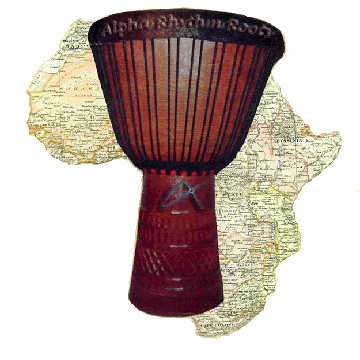Guinean traditional percussion orchestra
- alpharhythmroots

- Jan 29, 2021
- 4 min read
Transferred from an older blog: Original post date by Alpha (Administrator) in 2003
In Guinea, singing, playing music ,and dancing, is a part of everyday life. Percussion rhythms and songs are played by hunters, Jelis, and blacksmiths for specific occasions, and each rhythm has a specific meaning. Guinean rhythms (piece of music) are played all over Guinea, by Malinke, Soussou, Baga, Fula ethnic groups, and more.. Most percussive rhythms played in the modern orchestra, have typical dancing steps associated to them, together with sophisticated dancing choreography and multiple songs related to the rhythm. In a traditional environment, the percussion orchestra is meant to play for dancers which are really the highlight of the celebration / gathering. The following are some basics to play like in a Guinean traditional percussion orchestra. A basic Guinean traditional percussion orchestra is usually composed of 1 to 3 Double-sided drum players (Doundoufola), a few Djembe drum players for accompaniment (Djembedefola), and one Djembe soloist (Djembebafola). In the extended orchestra version, other musical instruments are also used, mainly the Bala, the Kora, the Bolon, the Fula flute, the Krin, and various shakers.
Each double sided drum (Doundoun) is usually played horizontally with one wooden stick (Kalama), and with a Bell (Kenke) attached to the drum. The bell is stroke with a nail or a metallic ring (Kourou) put around the finger, while the other hand simultaneously play one side of the drum with the stick.
The Doundoumba drum is the biggest - with a deep low pitch sound
The Sangbeni is the average sized one - with an average pitch sound
The Kenkeni is the smallest one - with a higher pitch sound.
Double-sided drums are played with a stick as a combination of open and closed notes.
Closed note (muffled sound) are achieved by leaving the stick on the drum skin, which stops the skin vibrations, providing a different sound from the open note.
Depending on the region, ethnic group, or the rhythms played, not all 3 drums will be played. Because of the wide area that the Mandingue empire used to cover, and the centre being close to the Guinean north-east border with Mali, many Guinean rhythms are also played in Mali, with some slight differences, the main one being that Malian do not usually use all three base drums, more specifically, not the Doundoumba (Biggest of the 3 double sided drums).
The Bells attached to the double-sided drums have 3 different sizes/tunes (respectively for each of the 3 double-sided drums), and when played properly in a rhythm, have their own melody. The Kenkeni (smallest) is often played without a bell. These 3 drums are sometimes also played in a vertical position by a single player with 2 wooden sticks (More recent "balai / show" style of playing).
Each rhythm is composed of a specific drumming pattern for each double-sided drum (Doundoun), as well as for at least 1 or 2 Djembes. (Accompaniment)
Considering each of the bells attached to the Doundoumba, Sangban and Kenkeni, the entire basic orchestra may combine up to 8 different patterns to form a rhythm (poly-rhythm).
A set of musical calls / breaks, as well as specific drumming pattern phrases, are used to signal beginning, changes, and end for the dancers and players in a specific rhythm. Beyond each drumming pattern, there is variations and particularly what is called "echauffement" (Heat up), which consist of going into a cycle of intense drumming based on more energetic and different drumming patterns for the dancers, to finally come back to the original drumming patterns. There are a few universal calls/breaks associated with ternary or binary time signatures, however, many rhythms have their own and specific breaks / introduction phrase, which makes them very unique and recognizable right away.
At least 1 Djembe is playing a steady and repetitive pattern which consolidate the doundoun melody.
Only one Djembe player at a time usually goes into a solo at any given time (lead Djembebafola improvising) to follow and embellish the dancers steps.
Whenever he ends its solo playing, another Djembe player can replace him (in the modern "ballet" orchestra version only).
Most rhythms have a complex mix of "Off beat" (also called "false accompaniment), which makes them a real challenge to play correctly and in good synchronization between all instruments. Proper timing and synchronization are very important to succeed in playing Guinea rhythms properly.
As far as Djembe playing, there are 3 basic sounds that are essential to be able to play: The base, the tone, and the slap (higher-sharper sound), despite the fact that a Djembe drum almost have an infinite number of sound that can be produced from it.
Having an authentic professional Djembe drum, properly tuned is necessary.
Furthermore, Djembe hands technique is definitely a key factor in playing these notes properly..
Traditional music has been evolving from a village form, with singing and a more natural way of starting rhythms, to a "ballet" orchestra version for public representations and shows with many breaks, signal and introduction phrases, with very little to no singing . Rhythms played in "ballet" also tend to be played at a much faster paste than they usually are in a village traditional environment, in order to highlight drummers skills.
The show concept where people only seat, listen and watch, is a more recent evolution of percussion orchestra that started with international touring of national percussion companies like "Ballet Africains" or "Percussion de Guinea".
Traditionally, everybody is included in the show and actively participating, so the orchestra and the crowd makes one.
There is a lot more to understanding and playing like in a Guinean traditional percussion orchestra.
Get to practice, join us and hear for yourself the unique sound that first echoed through West Africa, and now the world.
















Comments